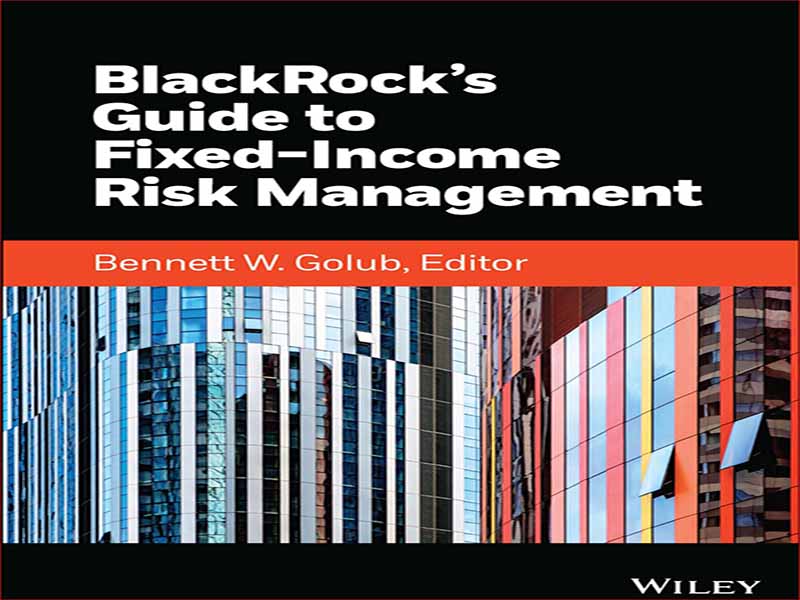- عنوان کتاب: BlackRock’s Guide to Fixed-Income Risk Management
- نویسنده: BENNETT W. GOLUB
- حوزه: مدیریت ریسک مالی
- سال انتشار: 2023
- تعداد صفحه: 445
- زبان اصلی: انگلیسی
- نوع فایل: pdf
- حجم فایل: 14.9 مگابایت
تغییر پویایی بازار، پیشرفت های تکنولوژیکی و استرس های ژئوپلیتیکی مدیریت ریسک سرمایه گذاری را متحول کرده است. با ظهور محصولات جدید و سفارشی، ریسک های جدید و پیچیدگی های اضافی باعث پیشرفت در فرآیندهای مدیریت ریسک و تجزیه و تحلیل شده است. برای مثال، تمام نوآوریهای اجباری و سریعی را که از همهگیری ویروس کرونا ناشی شدهاند، در نظر بگیرید. با توجه به تغییرات فراوان، مدیران ریسک مجبور به تطبیق فرآیندها و ابزارهای خود برای رسیدگی به تلاطم بازار، تغییرات ساختاری بازار اوراق قرضه، پیچیدگی محصول و افزایش نظارت نظارتی هستند. علاوه بر این، مدیران ریسک یاد گرفتهاند که از برخی از این پیشرفتهای فنآوری بهره ببرند که منجر به تجزیه و تحلیل بهتر و توانایی تجزیه و تحلیل مجموعه دادههای بزرگتر و گستردهتر میشود. فرهنگ مدیریت ریسک از نظر فکری کنجکاو، همراه با فرآیندهای مدیریت ریسک دقیق و شایستگی تکنولوژیکی، توانایی مدیران ریسک را برای انطباق سریع و مؤثر با شرایط جدید تسهیل میکند. شناخت ماهیت پویای مدیریت ریسک سرمایه گذاری به ما اطلاع می دهد که تقریباً مسلم است که برخی از ایده ها و روش های ارائه شده در این کتاب به ناچار خود منسوخ می شوند. به همین ترتیب، ناگزیر حذفهای مهمی وجود دارد، چه عمداً به دلیل محدودیتهای زمانی و چه خارج از خرد و دانش دست اول نویسندگان. این کتاب یک نسخه ویرایش شده و توسعه یافته مدیریت ریسک: رویکردهایی برای بازارهای با درآمد ثابت (2000) توسط BennettW است. گلوب و لئو ام تیلمن (نسخه اول). در 23 سال پس از انتشار اصلی به زبان انگلیسی، چیزهای زیادی برای تغییر شکل چشمانداز مدیریت ریسک سرمایهگذاری اتفاق افتاده است. برای مثال، توجه بیشتر بازارها و سرمایه گذاران به ویژگی های ESG (زیست محیطی، اجتماعی و حاکمیتی) هرگز در زمان انتشار کتاب اصلی تصور نمی شد. احتمالاً کتاب قطعی مدیریت ریسک ESG هنوز نوشته نشده است. این کتاب عمداً بسیاری از آن موضوع را حذف میکند، در حالی که این حرفه در انتظار یک حجم کامل از تمرین است. همچنین، در حالی که در حال حاضر یک موضوع داغ است و مطمئناً توانایی ایجاد چندین شکست مدیریت ریسک را نشان داده است، این کتاب عمداً در مورد مدیریت ریسک ارزهای دیجیتال سکوت کرده است. ما منتظر بلوغ فرآیندهای مدیریت ریسک آن بازارها هستیم. شدت فن آوری مدیریت ریسک سرمایه گذاری به طور چشمگیری افزایش یافته است. بیست و سه سال پیش، فناوری لزوما در خط مقدم اکثر شرکت های مدیریت سرمایه گذاری نبود. در حال حاضر، فناوری یکی از عوامل حیاتی موفقیت است – به شرکتها اجازه میدهد به تکامل خود ادامه دهند تا نیازهای مشتریان را برآورده کنند، به تغییرات بازار و الزامات نظارتی پاسخ دهند و کارایی و مقیاس عملیاتی ایجاد کنند. با پیشرفتهای فناوری، شرکتها اکنون میتوانند وظایفی را انجام دهند که قبلاً از نظر فناوری غیرممکن بودند یا برای مفید بودن سختافزار بسیار گرانقیمت یا زمان زیادی نیاز داشتند. هنگام ویرایش بخشهایی از کتاب اصلی برای گنجاندن در این ویرایش جدید، ارجاع به تکنیکهای تحلیلی که شامل به خطر انداختن دقت برای کارایی محاسباتی بود، از نسخه خطی حذف شد. به خاطر صرفه جویی در منابع محاسباتی، نیاز کمتری به به خطر انداختن دقت وجود دارد. پیامدهای قانون مور، به طور کلی، همچنان منابع محاسباتی را اقتصادی تر و بیشتر می کند. برای مثال، برنامههای مبتنی بر ابر، میتوانند مقادیر عظیمی از توان محاسباتی را در صورت تقاضا احضار کنند. سازمانها میتوانند مقادیر غیرقابل تصوری از دادهها را ارزانتر و سریعتر از همیشه ذخیره، تجزیه و تحلیل، دستکاری و ترکیب کنند. استفاده پیچیده و خلاقانه از فناوری، به بخش مهمی از مدیریت ریسک سرمایه گذاری موثر تبدیل شده است. داشتن فناوری مناسب برای مدیریت ریسک دیگر یک امر تجملی نیست. یک ضرورت است تعهد بلک راک به نوآوری و استفاده از فناوری یکی از عوامل کلیدی رشد مستمر آن بوده است. توسعه و تکامل علاءالدین و بهرهبرداری از فناوری بخشی از چشمانداز تاسیس BlackRock بوده است و این شرکت را قادر میسازد تا به یک اپراتور در مقیاس بزرگ، بسیار کارآمد، یکپارچه و پویا تبدیل شود. همانطور که شرکت رشد می کند و تکنولوژی تکامل می یابد، علاءالدین همچنان بهترین راه حل در کلاس است که توسط BlackRock برای کارکرد موثر در مقیاس استفاده می شود. همان فناوری علاءالدین مورد استفاده BlackRock نیز در دسترس است و توسط بسیاری از مؤسسات مالی بزرگ جهانی به شدت مورد استفاده قرار می گیرد. انگیزه این کتاب به دلیل پرس و جو از یک مشتری بلک راک در مورد زمان تجدید نظر در اولین نسخه آغاز شد. در ابتدا به نظر می رسید این کار نسبتاً ساده ای باشد و این پروژه در سال 2017 آغاز شد.
Changing market dynamics, technological advances, and geopolitical stresses have transformed investment risk management. As new and bespoke products have emerged, new risks and additional complexities have driven advances in risk management processes and analytics. Consider, for example, all the forced and rapid innovations that arose from the Coronavirus pandemic. Given the abundance of change, risk managers have had to adapt their processes and tools to address market turbulence, structural bond market changes, product complexity, and increased regulatory oversight. Additionally, risk managers have learned to take advantage of some of these technological advances, resulting in better analytics and the ability to analyze bigger and broader data sets. An intellectually curious risk management culture, coupled with rigorous risk management processes and technological competence, facilitates risk managers’ ability to rapidly and effectively adapt to new circumstances. Recognizing the dynamic nature of investment risk management informs us that it is almost certain that some of the ideas and methodologies presented in this book will inevitably become obsolete themselves. Similarly, there inevitably are important omissions, either intentionally due to the limitations of time or are outside the wisdom and firsthand knowledge of the authors. This book is a heavily edited and expanded edition of Risk Management: Approaches for Fixed Income Markets (2000) by BennettW. Golub and Leo M. Tilman (the first edition). In the 23 years following the original English language publication, much has happened to reshape the investment risk management landscape. For example, the heightened attention by markets and investors to ESG (environmental, social, and governance) characteristics was never envisioned when the original book was published. The definitive book on ESG risk management has probably not been written yet; this book intentionally omits much of that topic, while the profession awaits a conclusive state-of-the-practice volume. Also, while currently a hot topic and one that certainly has demonstrated the ability to generate multiple risk management failures, this book is intentionally silent on the risk management of cryptocurrencies; we await those markets’ risk management processes maturing. The technological intensity of investment risk management has increased dramatically. Twenty-three years ago, technology was not necessarily at the forefront of most investment management firms. Now, technology is one of the critical success factors—allowing firms to continue to evolve to meet clients’ needs, respond to market changes and regulatory requirements, and create operational efficiencies and scale. With improvements in technology, firms are now able to perform tasks that were previously technologically impossible or would take too much time or too much expensive hardware to be useful. When editing sections of the original book for inclusion in this new edition, references to analytic techniques that involved compromising accuracy for computational efficiency were removed from the manuscript; there is much less need to compromise precision for the sake of economizing computational resources. The implications of Moore’s Law, broadly speaking, continue to make more and more computational resources economical. Cloud-based applications, for example, can summon massive amounts of computational power on demand. Organizations can store, analyze, manipulate, and synthesize what would have been unimaginable amounts of data more cheaply and quickly than ever before. The sophisticated and creative use of technology, has become an essential part of effective investment risk management. Having the right technology to manage risk is no longer a luxury; it is a necessity. BlackRock’s commitment to innovation and the use of technology has been one of the key drivers of its ongoing robust growth. Developing and evolving Aladdin and leveraging technology has been part of BlackRock’s founding vision and has enabled the firm to become a massive scale operator, highly efficient, integrated, and dynamic. As the firm grows and technology evolves, Aladdin continues to be a best-in-class solution, used by BlackRock to operate efficiently at scale. The same Aladdin technology used by BlackRock is also available and heavily used by many major global financial institutions. The motivation for this book originated due to an inquiry from a BlackRock client about when the first edition would be revised. Initially, this seemed to be a relatively straightforward task, and the project was initiated in 2017.
این کتاب را میتوانید از لینک زیر بصورت رایگان دانلود کنید:

































نظرات کاربران